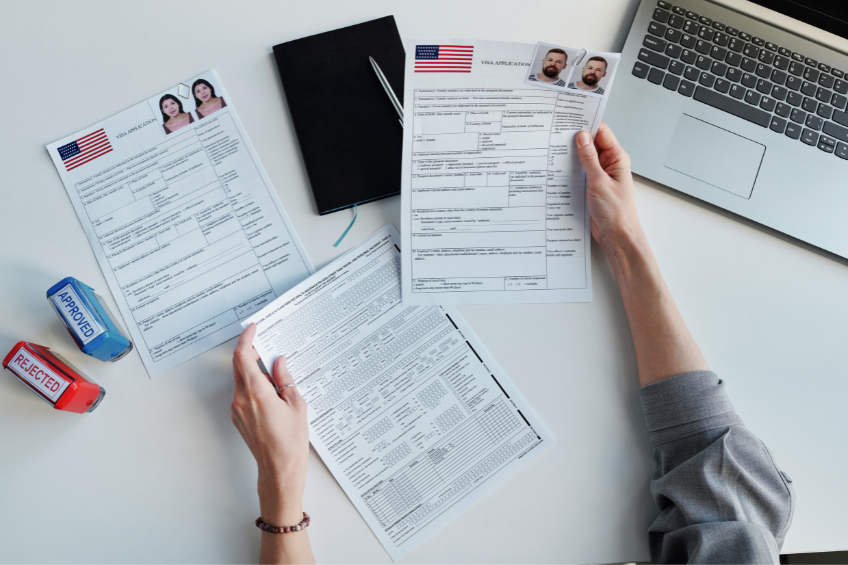Filing Form I-485 (Application to Register Permanent Residence or Adjust Status)means you are one step closer to becoming a United States permanent resident. Still, you are not quite there yet, so you do not have all the freedom that an actual green card holder has.
To be more precise, while waiting for your adjustment of status under most types of visa, you can’t leave the country and return at your will. In fact, a specialized travel document must be obtained to allow you to travel abroad and re-enter the United States while waiting for a pending Form I-485 adjustment of status.
Traveling abroad is possible in some situations by applying for an Advance Parole document, which will prevent your adjustment of status application from being considered abandoned.
Although it is possible, it does not mean it is advised because it is risky! Knowing the complexity of U.S. immigration law, you must be diligent and avoid actions that could harm your case.
This article aims to clear the water on what you can and cannot do while waiting impatiently for your adjustment of status application.
Let’s define Adjustment of Status.
Adjustment of Status can be defined as the green card application process, which can be used by those already living in the United States. The green card process is also known as becoming a lawful permanent resident (LPR).
The adjustment of status is considered pending between the filing of Form I-485 and the approval or denial of your application.
Form I-485 explained
Form I-485 is used to file for an application to change an immigrant status. When this petition is approved, the applicant becomes a permanent resident (a “green card” holder).
Option to travel outside the U.S. while waiting on a pending Adjustment of Status application
Generally speaking, to be able to travel abroad while waiting on the pending I-485, you need to get an Advance Parole document issued by the USCIS. You will receive an I-512 L (Authorization for Parole of an Alien into the United States) if approved.
There are a few exceptions where specific categories of nonimmigrant visa holders, such as H-1B and L-1, don’t need to obtain the Advance Parole to travel outside the country.
The Advance Parole – Travel Document
The Advance Parole travel document can determine your ability to travel outside the U.S. and return when your H-1B visa has expired, or your I-94 departure date has passed.
Advance Parole is a special travel document that allows a person whose green card application status is still pending to leave and re-enter the United States without a valid visa.
Important: the USCIS established that entering the country under this situation means the person becomes a “parolee” and is no longer under a nonimmigrant status.
Moreover, it is not considered a visa or a re-entry authorization but rather a one-time exception to the rule, as it does not authorize departure under that circumstance.
Requesting an Advance Parole Document
To obtain an Advance Parole document, the applicant must file Form I-131 (Application for Travel Document) carefully since this document has different variations, and applying for the wrong one can impose inadmissibility back in the U.S. as a result of the abandonment of a pending AOS application.
In any circumstance, assume that you have permission to travel while your I-485 adjustment of status application is pending, solely on the fact that you have filed Form I-131. The USCIS states that if the applicant departs before the approval of Form I-131, the pending I-485 adjustment of status will be deemed abandoned.
How to apply for Travel Document – Form I-131
Along with prepared and signed Form I-131, you must submit the following evidence:
- Copy of a government-issued identity.
- Copy of Form I-797 (Notice of Action), approval notice of an application for pending application for adjustment of status.
Form I-131 Filing Fee
- General filing fee: $ 575
- Biometrics services (ages 14 to 79*): $ 85
Total: $660
Note: Biometric services are not required from applicants 13 or younger and 80 or older.
Important thing to consider about leaving the United States while having a pending I-485 application
We can’t stress enough to say that the Advance Parole or travel document is not the golden ticket that will guarantee your acceptance back into the country. It only keeps your adjustment of status application alive.
Acceptance into the U.S. is at the discretion of the Border Patrol Officer at the U.S. port of entry. Therefore, he can inspect you and deny your entry at his discretion.
For that reason, traveling abroad with a pending I-485 status is strongly discouraged If there is not something extremely urgent that really needs your attention.
Consequences of traveling abroad without a Travel Document
Traveling abroad without having an I-131 approved: in this situation, adjustment status applicants would be deemed as abandoning their I-485 case.
The USCIS establishes exceptions for traveling without an Advance Parole document for the following categories of nonimmigrant visa:
- H-1 (temporary worker) or H-4 (spouse or child of H-1 visa holder);
- L-1 (intracompany transferee) or L-2 (spouse or child of L-1 visa holder);
- K-3 spouse or a K-4 child of a U.S. citizen;
- V-1 spouse or V-2 or V-3 child of a green card holder.
Conclusion
As you can see, traveling abroad while waiting for the final say on your green card application, in other words, traveling while your I-485 process is pending, is possible in most cases, although hazardous and certainly discouraged by immigration experts unless you fall into the exception categories.
If you need an immigration expert to help you with your adjustment of status, H-1, E-B1, or O-1 needs, we are here to help! Contact us!
FAQ:
What does it mean to have a pending adjustment of status after filing Form I-485?
It means that your immigration status is considered pending between the moment you file Form I-485 and the approval (I-551 – Evidence of Permanent Residence) or denial (I-797 -Notice of Action).Why do I need to get a travel document before leaving the United States if I have a pending I-485 case?
While waiting for your adjustment of status, you can only leave the country and return if you have received a travel authorization document issued by the USCIS. Your green card application will be deemed abandoned if you fail to obtain the proper travel document. This rule does not apply to certain types of nonimmigrant visa holders.After getting an Advance Parole travel document, how long can I be outside of the U.S.?
The advance parole document is usually valid for up to 12 months. It advises that when traveling on this document, you stay abroad the absolutely necessary and not in any circumstance stay out of the U.S. after the expiration of the travel document.How Many Times Can I Use Advance Parole to Re-enter the U.S.?
The Advance Parole is not considered a visa or a re-entry authorization but rather a one-time exception to the rule, meaning it can only be used once. Because once admitted back into the U.S., you will be under parolee status, not a nonimmigrant status. If you fall into the exception visa categories (H-1, H-4, K-3, K-4, L-1, L-2, V-1, V-2, and V-3), the single re-entry rule does not apply to you.Who cannot apply for Advance Parole?
Individuals living in the United States unlawfully; an exchange alien subject to the foreign residence requirement; those who have utilized the advance parole document before; and individuals under removal proceedings.Is it possible to be denied entry into the U.S. despite having Advance Parole?
Acceptance into the U.S. is at the discretion of the Border Patrol Officer at the U.S. port of entry. Therefore, he can inspect you and deny your entry at his discretion. For that reason, traveling abroad with a pending I-485 status is strongly discouraged If there is not something extremely urgent that really needs your attention or you keep your H-1B nonimmigrant status valid until you receive your green card.









